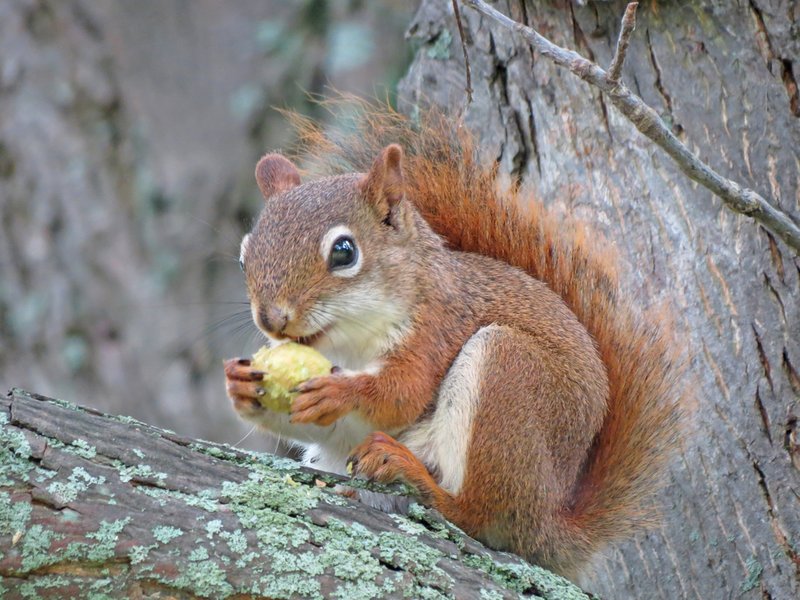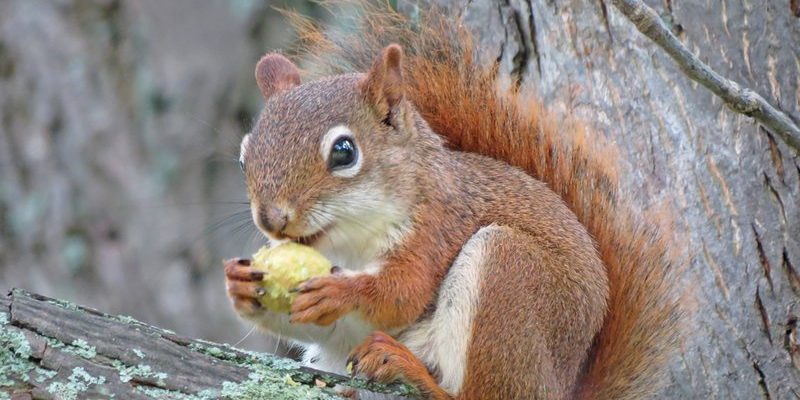
The American Red Squirrel is one of nature’s most delightful little creatures. With its bright reddish-brown fur and bushy tail, this energetic squirrel can often be spotted scampering up trees or darting across the forest floor. You might think of them as the acrobats of the animal kingdom, always seemingly in a hurry, and they play an essential role in their ecosystem. These lively furry friends not only entertain bird watchers and nature lovers, but they also contribute to the health of the forests they inhabit.
Imagine sipping your morning coffee while watching a curious American Red Squirrel dash up a tree, pausing to check its surroundings before continuing its quest for food. You might wonder how such a small animal can be so full of life, and that’s the magic of the American Red Squirrel. In this article, we’ll dive into their habits, habitats, and all the fascinating details about these lively little critters.
Physical Characteristics
When you first see an American Red Squirrel, the vibrant colors of its fur can really catch your eye. Typically, they have a coat that ranges from reddish-brown to gray, depending on their specific habitat and age. Adults generally weigh between 5.5 to 8.8 ounces, and their body length can be about 8 to 10 inches, not including their bushy tails, which can add another 7 to 8 inches. Their tails aren’t just for show; they’re crucial for balance, especially when they perform their daring jumps between tree branches.
One of the standout features of the American Red Squirrel is its large, expressive eyes that help it navigate through its environment. These little guys also have sharp claws that allow them to grip tree bark easily, making climbing look as easy as a walk in the park. The fur on their tails often appears more lush during the colder months, providing warmth and insulation against chilly weather.
In terms of markings, they have a distinct white ring around their eyes, adding to their charming appearance. This not only helps in communication among squirrels but also adds to their overall cuteness factor. You might find it interesting that their fur color can change with the seasons as a natural adaptation to their environment.
Habitat
The American Red Squirrel primarily prefers coniferous forests, where it can thrive among the branches of evergreen trees. Think of these squirrels as true forest dwellers, as they make their nests in tree cavities or build dreys—those cozy nests made from twigs and leaves high up in the branches. These secluded spots offer safety from predators and a strategic location to gather food.
Although their preference is for forests, you can also find them in parks and gardens, especially where conifer trees are present. Urban areas aren’t off-limits either! They can adapt to human environments, and you might spot them in your backyard or local parks, especially if you have bird feeders filled with seeds. Their adaptability showcases their resilience, and it’s fascinating to see how they navigate through different environments.
American Red Squirrels are typically found throughout North America, with concentrated populations in areas like Canada and the northeastern United States. They are particularly fond of habitats that provide a reliable food source, such as pine nuts, seeds, and fruits. These habitats are critical not just for their survival, but also for maintaining the balance in their ecosystems by planting seeds as they forage.
Diet
If you’ve ever wondered what fuels the energy of the American Red Squirrel, look no further than their varied diet! These squirrels are primarily herbivores and they absolutely love conifer seeds, acorns, and nuts. You might catch them cracking open a pine cone—something they’ve mastered over eons—using their sharp teeth to get to the delicious seeds inside. It’s almost like watching a tiny chef at work, preparing their meal with great precision.
In addition to seeds and nuts, they can also munch on fruits, berries, and even fungi. Yes, you heard that right! The American Red Squirrel has a diverse palate which allows it to thrive in various environments. This adaptability in diet is crucial for survival, especially during harsh winters when food can be scarce.
During the fall, you can observe them gathering and storing food for the winter months, a behavior known as caching. They bury their food in various locations, a practice that can sometimes lead to accidental planting of new trees—talk about a dual purpose! This habit not only helps them survive winter but also aids in forest regeneration, making them essential players in their habitats.
Behavior
The behavior of the American Red Squirrel is as vibrant as its appearance. They are known for being highly territorial, often defending their patches of forest with agility and fierce determination. If you’re lucky enough to observe a couple of them in their natural habitat, you might see them chasing each other around the trees or chattering loudly—almost as if they’re having a conversation or arguing over territory!
These squirrels are diurnal, meaning they are most active during the day, especially in the early morning and late afternoon. During these hours, you’ll notice them foraging, climbing, and engaging in play. Their social structure is fascinating too; while they may seem solitary, they do engage in social interactions. You might find them communicating through a range of calls, whether it’s a gentle chirp or a more alarmed, chattering sound when they sense danger.
One of their most interesting behaviors is how they handle the challenges of winter. They have a unique way of adapting by finding food sources they’ve hidden earlier — a practice that not only helps them survive but also keeps their minds sharp. The American Red Squirrel is a prime example of resilience and adaptability in the wild, showcasing a spirit that many can admire.
Reproduction and Lifespan
The mating season for the American Red Squirrel typically occurs in late winter and early spring, but it can vary depending on their specific location. During this time, males become quite competitive, showcasing their skills to attract females through vocalizations and impressive leaps among the trees. If you observe their interactions, you may witness some fascinating courtship behaviors, as they chase each other playfully or engage in displays of agility.
After a gestation period of about 30 to 40 days, a female squirrel typically gives birth to a litter of 2 to 8 kits. These little ones are born blind and hairless, relying entirely on their mother for nourishment and protection. As they grow, they start to develop their fur and begin to open their eyes roughly three weeks after birth. It’s a delight to see these tiny creatures grow and learn to navigate the world around them.
The American Red Squirrel has a lifespan of around 3 to 5 years in the wild, although some have been known to live longer under the right conditions. Factors affecting their lifespan include availability of food, habitat quality, and predation. In captivity, they can live significantly longer, sometimes reaching up to 10 years or more. The life of an American Red Squirrel is a colorful journey, marked by challenges and triumphs that shape their resilient nature.
Conservation Status
As of now, the American Red Squirrel is not considered endangered, but like many wildlife species, they face challenges that can impact their population. Habitat loss due to urban development and deforestation poses significant threats to their natural homes. You might be surprised to learn that when trees are cut down, squirrels lose not just their nests, but also their vital food sources.
Interestingly, conservation efforts can make a difference. Creating awareness about the importance of forests and promoting responsible land use can help protect these adorable creatures. Communities can contribute by planting trees and maintaining natural spaces that support their habitats. It’s a simple yet effective way to ensure that American Red Squirrels continue to thrive.
Encouraging biodiversity also plays a significant role in conservation. By appreciating all wildlife, including the American Red Squirrel, and understanding their roles, we can foster environments where they can flourish. After all, every species, no matter how small, has its part to play in the larger tapestry of life.
Fun Facts
- The American Red Squirrel can leap up to 10 times its body length!
- They have a unique way of communicating with a variety of chirps and clicks.
- Their bushy tails serve as parachutes when they jump from heights, helping them land safely.
- These squirrels are known for their exceptional ability to find buried food, even under snow!
- American Red Squirrels can be found in different regions, adapting to a variety of climates.
FAQ
What is the American Red Squirrel’s habitat preference?
The American Red Squirrel prefers coniferous forests but can adapt to urban parks and gardens with suitable trees. They thrive in environments that provide ample food sources, particularly those with evergreens, where they can easily forage for seeds and nuts.
How do American Red Squirrels communicate?
These lively little creatures communicate through a variety of vocalizations, including chirps and alarm calls. Each sound conveys different messages, from warning other squirrels about predators to signaling excitement during playful chases.
What do American Red Squirrels eat?
Primarily herbivores, American Red Squirrels feast on seeds, nuts, fruits, and even fungi. Their diet mainly consists of conifer seeds and they are known to cache food for the winter months, burying it in various locations to retrieve later.
What role do they play in their ecosystem?
As foragers, American Red Squirrels play a critical role in forest ecosystems by helping in seed dispersal. When they bury their food, some seeds can germinate and grow into new plants, which helps forest regeneration and biodiversity.
How do American Red Squirrels adapt to winter conditions?
During winter, American Red Squirrels rely on their cached food supplies to survive. They have a thick coat that provides insulation and can find food beneath the snow, showcasing their resourcefulness and adaptability.
How long do American Red Squirrels live?
In the wild, American Red Squirrels typically live around 3 to 5 years, although some can live longer with optimal conditions. In captivity, they can reach lifespans of 10 years or more, since they are protected from natural predators and have reliable food sources.
Are American Red Squirrels active year-round?
Yes, American Red Squirrels are active throughout the entire year. They don’t hibernate, but they do adapt their behavior in winter by relying on stored food and being more cautious about their movements to avoid predators.
Do American Red Squirrels have natural predators?
Yes, they face threats from various predators, including hawks, owls, snakes, and even domestic cats. Their excellent climbing skills and keen senses help them evade capture by escaping into trees where they can hide.
How can I attract American Red Squirrels to my backyard?
If you want to attract American Red Squirrels, consider putting up a squirrel feeder with seeds or nuts. They’re also drawn to gardens with fruit-bearing plants or trees. Remember to provide hiding spots, like shrubs or trees, for them to feel safe!
Are American Red Squirrels territorial?
Yes, these squirrels are quite territorial, often defending their foraging areas from other squirrels. They will chase off intruders and communicate their presence through vocalizations, ensuring their space is secured.
Can American Red Squirrels be found in urban areas?
Absolutely! American Red Squirrels can adapt to urban settings, especially where there are trees and parks. They often find suitable habitats in city parks and gardens, proving their remarkable adaptability to different environments.

